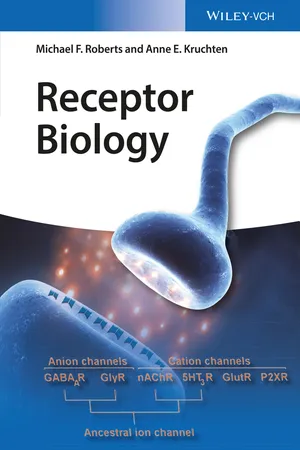Biological Sciences
Cell Communication
Cell communication refers to the process by which cells send and receive signals to coordinate their activities. This communication is essential for various biological processes, including growth, development, and immune responses. Cells communicate through chemical signals, such as hormones and neurotransmitters, as well as through direct contact and electrical signals.
Written by Perlego with AI-assistance
Related key terms
6 Key excerpts on "Cell Communication"
- Gerhard Krauss(Author)
- 2014(Publication Date)
- Wiley-VCH(Publisher)
Cellular communication assumes great importance in the differentiation and development of an organism. The development of an organism is based on genetic programs that always utilize inter- and intracellular signaling pathways. Signal molecules produced by one cell influence and change the function and morphology of other cells in the organism.Intercellular signaling pathways are also critical for the processing of sensory information. External stimuli, such as optical and acoustic signals, stress, gradients of nutrients, and so on, are registered in sensory cells and are transmitted to other cells of the organism via intercellular signaling pathways.1.2.1 Tools for Intercellular Signaling
Various forms of communication between cells are currently known (Figure 1.2 ):- Extracellular messengers: Cells send out signals in the form of specific messenger molecules that the target cell transmits into a biochemical reaction. Signaling cells can simultaneously influence many cells by messenger molecules so as to enable a temporally coordinated reaction in an organism.
- Gap junctions: Communication between bordering cells is possible via direct contact in the form of “gap junctions.” Gap junctions are channels that connect two neighboring cells to allow a direct exchange of metabolites and signaling molecules between the cells.
- Cell–cell interaction via cell-surface proteins: Another form of direct communication between cells occurs with the help of surface proteins. In this process, a cell-surface protein of one cell binds a specific complementary protein on another cell. As a consequence of the complex formation, an intracellular signal chain is activated which initiates specific biochemical reactions in the participating cells. Communication is then only possible upon direct contact between the target cell and the surface protein of the partner cell.
- Electrical signaling:
- eBook - ePub
Lecture Notes
Human Physiology
- Ole H. Petersen(Author)
- 2019(Publication Date)
- Wiley-Blackwell(Publisher)
Chapter 2 Cellular CommunicationCells communicate with one another by chemical and electrical signals. There are also specialized sensory cells that respond to chemical, electrical, light, mechanical or heat stimuli that may come from external or internal sources. The cellular response to these signals may be simple and short-lived, such as depolarization, or it may be complex and long-lasting, such as the acquisition of memory. Nevertheless, the cellular mechanisms underlying these responses have much in common. Each of these signals is transduced into electrical or biochemical changes within the cell, which lead to a characteristic response. For example, the stimuli that give rise to the sensations of taste, smell, hearing and vision, and also certain neurotransmitters and hormones, can all control the opening and closing of ion channels and depolarize or hyperpolarize cells.In this chapter we discuss how information is transmitted between cells, and how signals from the external and internal environment are received and transduced into electrical and biochemical changes within the cell.2.1 How signals are transmitted between cells
Cells communicate with one another by chemical signals that either diffuse between cells (neurotransmitters, and paracrine and autocrine agents), or are disseminated in the blood (hormones). These signals include small organic molecules (e.g. acetylcholine and adrenaline), and larger molecules such as proteins and steroids. Cells may also communicate with their immediate neighbours through gap junctions, which transmit both electrical and chemical signals. - eBook - ePub
- Michael F. Roberts, Anne E. Kruchten(Authors)
- 2016(Publication Date)
- Wiley-VCH(Publisher)
Signaling is the means by which a cell knows what is happening in its surroundings, and is also the method by which one cell instructs nearby cells to alter their behavior. Organismal cell signaling involves molecular interactions, but the biological mechanisms of signaling are analogous to the ones humans use for verbal communication.1.1.2 Verbal and Physiological Signals
Any sort of signaling requires that the sender and receiver are capable of interpreting the signals in the same way [3]:- The sender must relay a characteristic signal, and it must be received by a characteristic device;
- The signal is arbitrary: it bears no real relation to the process it starts but is simply a way of obtaining a response in the receiver;
- The signal is simpler than the process it sets in motion.
- The signals are the words of the language, and the receiver is the hearing/thinking/acting apparatus of another person;
- Each language uses different words, yet all people can express the same thoughts.
- Any word (e.g., HELP) evokes in its hearer a set of thoughts or behaviors that are much more complex than the word itself.
- The correct signal is the drug or hormone, the correct receiver is the cell surface receptor or nuclear receptor.
- It is arbitrary that one amino acid (e.g., glutamic acid) is an excitatory transmitter
- eBook - ePub
Evolutionary Biology
Cell-Cell Communication, and Complex Disease
- John S. Torday, Virender K. Rehan(Authors)
- 2012(Publication Date)
- Wiley-Blackwell(Publisher)
4 THE EVOLUTION OF CELL–Cell Communication Two roads diverged in a wood, and I—I took the one less traveled by,And that has made all the difference.—Robert Frost, The Road Not Taken- Cell–Cell Communication as the Mechanistic Basis for Evolutionary Biology
- The Darwinian Biologic Spacetime Continuum and Einstein’s Vision of the Universe
- Reverse Engineering of Physiologic Traits as a Portal for Viewing Evolution
- Cell–Cell Communication as the Basis for the Evolution of Metazoans
- Understanding Lung Evolution from the Middle Out
- The Cell–Cell Communication Model of Lung Evolution Traces Contemporary Phenotypes Back to Ancestral Phenotypes
- Predictive Value of the Lung Cell–Cell Communication Model for Understanding the Evolution of Physiologic Systems
- Sexual Dimorphism of Lung Development: A Case Study in Cell–Cell Communication and Evolutionary Plasticity
- Androgen Affects the Expression of Growth Factors Involved in Lung Development
- Evidence for an Association between Steroid-Resistant/Responsive Phenotypes and Human Lymphocyte Antigen (HLA) Haplotypes
As a preamble to this chapter, we present the suggestion by E. O. Wilson in his book Consilience that since all human knowledge is rapidly being reduced to 1s and 0s by computers, we could create a common database across all disciplines. In so doing, Wilson challenges us to generate a unifying theory for biology in order to fulfill this promise, because without such a theory, we have only disorganized information and anecdotes (Wilson 1998).CELL–Cell Communication AS THE MECHANISTIC BASIS FOR EVOLUTIONARY BIOLOGY
Cell–Cell Communication provides common ground for understanding complex biologic processes ranging from development to physiologic homeostasis, regeneration, and aging, all of which are functional phenotypes generated by evolution. But more importantly, cell–Cell Communication is the mechanistic basis for the process of evolution - eBook - ePub
Biochemical Pathways
An Atlas of Biochemistry and Molecular Biology
- Gerhard Michal, Dietmar Schomburg(Authors)
- 2013(Publication Date)
- Wiley(Publisher)
Chapter 7 Signal Transduction and Cellular CommunicationGerhard NiederfellnerMulticellular organisms require signal transduction systems to coordinate the cellular activities. This can take place the humoral way (hormones in plants and animals) or the neuronal way (only in animals). This chapter deals with the situation in vertebrates.Both communication systems cannot be exactly separated; there are various connections between them. In the following, hormones are discussed first (7.1), acting mainly extracellularly both on non-neural cells and within the nerve system. Thereafter, neuronal signal transmission (7.2) and finally intracellular signal processing (7.3 … 7.7) are described.7.1 Intercellular Signal Transmission by Hormones
7.1.1 General Characteristics of Hormones (Table 7.1-1 )
Hormones are chemical signal transmitters, which are transferred humorally to their target cells. They are synthesized in hormone glands (glandular hormones, this section)- various cells [non-glandular hormones, such as tissue hormones (7.1.9, 7.4.8, 9.2.2) and cytokines (8.1.8)]
- nerve cells (neurohormones, 7.2).
They act on the targets in different ways:- autocrine : acting on the same cell
- juxtacrine : membrane bound hormones need direct contact to an adjacent target cell
- paracrine : acting on neighboring cells
- endocrine : acting on distant cells.
Table 7.1-1 Hormones Grouped According to FunctionHormones belong to various chemical classes. Peptide hormones are frequently synthesized as prohormones, which are later cleaved to yield the final hormone. Many hormones are stored in vesicles (secretory granula) and released upon arrival of appropriate signals, e.g., changes of the intracellular Ca++ concentration (7.4.4). The hydrophobic steroid and thyroid hormones are bound to carrier proteins for their transport in blood.Hormone concentrations are usually very low (107 … 10−12 mol/l). Frequently, a hormone cascade exists, where an endocrine hormone causes the generation of another one in a different tissue and so on. A functional grouping of hormones is given in Table 7.1-1 - eBook - ePub
Biochemistry Explained
A Practical Guide to Learning Biochemistry
- Thomas Millar(Author)
- 2018(Publication Date)
- CRC Press(Publisher)
15 Cellular Communication In this chapter you will learn about:- the differences between hormones and neurotransmitters
- the main types of cellular receptors; ligand gated ion channels, transducer type receptors, and steroid receptors
- the importance of ion distribution across cell membranes and ion channels
- the main second messenger pathways in cells and how they are acdvated
- G proteins, kinases, calcium, cAMP, diacylglycerol, inositoltrisphosphate
- how prostaglandins are formed and some of their functions
- the location and mechanism of action of steroid receptors
Overview of intercellular messengers and receptors
With few exceptions, cells use chemicals such as hormones, neurotransmitters and cytokines to communicate with each other. This concept can be extended further to include communication between intracellular compartments, particularly the cytosol with the nucleus.Q&A 1: What is: a hormone; neurotransmiter; and cytokine?Study tip: Questions like the definitions above are commonly set as exam questions and seem simple, but if you enter an exam without having practised answering definitions, then expect to do poorly. The problem is that when you are studying you think that you know these and therefore do not bother to practise them. In an exam, when you actually have to write the definition you struggle to find the right group of words that define, e.g. a hormone. Your thoughts will be something like this: ‘I know this! It’s a ummm it’s a… you know, it’s released and well it ummm…, I know but I just cannot explain it.’ Not only have you wasted time, you have not answered a simple question, which in effect, you do know the answer to. This is a further disaster because you begin to lose confidence in your ability to answer other questions.To solve this problem, make sure that you can answer such questions by practising them at home. Do not assume that you know information when you are studying, but actually test yourself by writing or saying aloud the answer. Do not use a textbook definition, but put together your own group of words. Textbook definitions are useful until you have to regurgitate them in an exam and then you tend to get them a bit muddled because they do not use the style or vocabulary that you would normally use.
Learn about this page
Index pages curate the most relevant extracts from our library of academic textbooks. They’ve been created using an in-house natural language model (NLM), each adding context and meaning to key research topics.





